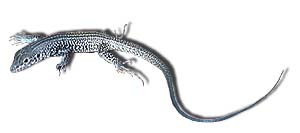
Cnemidophorus tigris
(Western Whiptail)

|
Key Characteristics |
|
Long tail (more
than twice length of body) |
General
Description:
Depending on
the individual, Western Whiptails may appear to have a light
ground color that is marked by a dark reticulated (network) pattern, or
they may appear to have a dark ground color that is marked by numerous light
colored spots. Regardless, there is always a striped
pattern that is apparent (even if faded or obscure). The four stripes
are a light tan, gray or cream color and extend dorsolaterally from the base
of the head towards the tail. The stripes are most prominent in juveniles,
and they tend to fade posteriorly in adults. The previously described
pattern of contrasting spots and markings extends onto the base of the tail,
but the color darkens towards the tip, becoming a solid bluish-gray. Juveniles
have more of a bluish tinge to their tail coloration (although not as vivid
as with Western Skinks). Western Whiptails have fine, granular scales
dorsally, and large rectangular scales
arranged in 8 rows ventrally. The lower limbs of these lizards have
a distinct scalation, being covered anteriorly with large, smooth scales that
contrast with the granular scales elsewhere on the limbs. In fact, the
genus name loosely translated means "bearing armored legs".
Western Whiptails are medium-sized lizards, and can reach lengths comparable to the Longnose Leopard Lizard and the Mojave Black-collared Lizard. However, due to their long slender body and whip-like tail Western Whiptails are not as massive as the other two species of lizard. Western Whiptails can attain snout-vent lengths of 112 mm (4.5 in.) and 330 mm (13 in.) in total length (Storm and Leonard 1995). The long tail of the Western Whiptail can be more than twice the snout-vent length if it is unbroken (Nussbaum et al. 1983). There is a fair chance that a Western Whiptail may be encountered with a tail that is regenerating, as they will readily lose their tail to predators and would be captors.
Western Whiptails mate in the spring, laying 1-4 eggs in June or July, which in turn hatch in August (Storm and Leonard 1995). The juveniles resemble the adults but are more vividly colored (including the tail, which is more blue in coloration).
Habitat:
Western Whiptails
are found in desert regions that have moderate to limited amounts of vegetation
such as sagebrush
or shadscale. The substrate may range from sand,
gravel, hardpan or loess, but regardless of type, burrows seem to be an important
component. Rocks on the other hand, don't seem to be necessary like they
are to some other Idaho lizard species.
Idaho
Distribution:
Western Whiptails are restricted to the
southwestern portion of the state. From Oregon and Idaho, south to southern
Baja California and northern Mexico, and from California east to Colorado and
Texas.
Diet:
Eats insects, spiders, scorpions, and lizards.
Known to eat Lepidopterans, crickets, grasshoppers, and beetles.
Ecology:
Hibernates![]() /aestivates
/aestivates![]() .
Active from April to September in northern range. Juveniles may be active on
warm days in winter in southern range. In Idaho, individuals are active in early
spring (mid-April), aestivate during middle part of summer, and are active again
during late summer and early fall. When inactive, individuals remain in underground
burrows dug by rodents or lizards. Colorado study determined that adult
home range averaged about 0.10-0.13 ha; population density was about 17/ha.
In Idaho, heavy predation results from active foraging behavior; tail breakage
exceeds 50% in large adults in some populations. Individuals in Idaho are larger
than those in more southern areas.
.
Active from April to September in northern range. Juveniles may be active on
warm days in winter in southern range. In Idaho, individuals are active in early
spring (mid-April), aestivate during middle part of summer, and are active again
during late summer and early fall. When inactive, individuals remain in underground
burrows dug by rodents or lizards. Colorado study determined that adult
home range averaged about 0.10-0.13 ha; population density was about 17/ha.
In Idaho, heavy predation results from active foraging behavior; tail breakage
exceeds 50% in large adults in some populations. Individuals in Idaho are larger
than those in more southern areas.
Reproduction:
Female produces 1 clutch/yr in northern
range, 2 (perhaps 3) in south (1 clutch in Idaho). Clutch size is smaller in
north than in south (average 2.7 in Idaho). Young reach sexual maturity in 20-23
mo in Idaho and Colorado, and probably at end of first year in far southern
range.
Conservation:
|
Status: |
Unprotected nongame species |
|
Global Rank: |
|
|
State Rank: |
S4 |
Important State Reference:
Burkholder, G.L. and J.M. Walker.
1973. Habitat and reproduction of the desert whiptail lizard Cnemidophorus
tigris in southwestern Idaho at the northern part of its range. Herpetologica
29:76-83.